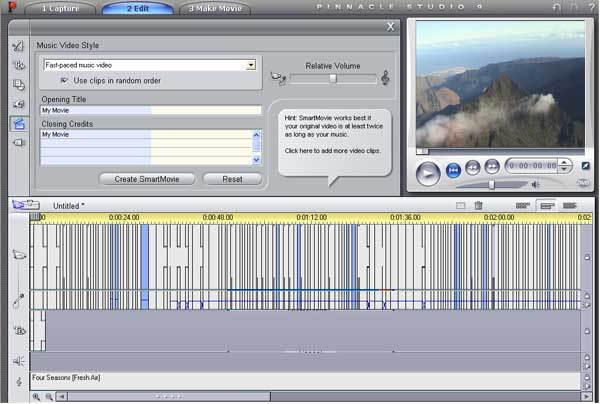Sky's the Limit Video Editing: Pinnacle Studio 9
The Lazy Way To Edit
Wizards are all the rage, and ultimately they are supposed to make work steps easier and minimize the time used. For video, that means automatic film editing. Certainly, there is a learning curve to video editing, and it takes time. But that isn't because of the computerization - it has to do with the complex nature of moving pictures. Creating an entertaining film is something that has to be learned. Even when filming you have to decide exactly what you want. Not even the best software can help a botched shot filmed while holding a camera with a hand that is shaking erratically.
Every manufacturer of video editing products tries to entice the buyer with comprehensive libraries for sophisticated transition effects, such as "page turn" transitions when changing scenes. Just go to the movies and watch a well-produced movie. Page turn transitions are used extremely rarely between two scenes. Instead, Hollywood prefers hard cuts, and at times a fade-out. The same with music videos and news reports. The reason is easy to see: Transition effects demonstrate the technical possibilities, but they distract from the action. "Real" visual effects are the trade of specialized companies such as Dreamworks. The "Matrix" films or "Jurassic Park" are classics, but usually months of intensive design and computing go into them. To interfere with the power of suggestion, video-editing products for the home user can't do that sort of thing. Only simple effects are possible, such as making the video look like scratchy silent film in black-and-white with image gremlins or casting artificial color over a scene for a twilight effect.
A practical option, however, is the Caption tool, which can be used for the title and credits or only for showing text like "Our hotel at Miami Beach".
Still, in SmartMovie, Pinnacle has created a tool for video editing that, on a closer look, is a lot more interesting. But don't be fooled by the term "automatic": this is a marketing term only.
You can only use SmartMovie if your film does not follow a particular scenario and the sequences can be stopped short in a random manner. Then the software takes care of two aspects: the rhythm of the editing and insertion of a music track, which represents a very useful aid two aspects that can be extraordinarily hard to master. Without a good deal of experience, you have to try numerous times before you find the right rhythm in number and length of sequences. Also, combining it with a soundtrack is often a nightmare. If you use SmartMovie, you only need to drag as many clips as you want into the timeline, add music and choose a style like "fast and rhythmical" or "simple and elegant". Studio then takes over, editing the video and inserting the music. The result is amazing, especially because the program doesn't overdo the transition effects. Depending on your original sound, you can also set the volume of the two soundtracks.
SmartMovie won't help you in the case of a documentary or feature film. If you want to tell a story or document the development of your offspring, it won't be suitable, because then it's up to you to decide what's important. But if you have shots from a somewhat unusual vacation, like a safari in Africa or a ski run with torches, SmartMovie can help you make a film that will not bore the audience. There is nothing worse, for example, than a half-hour of the Coliseum in zoom mode.
Get Tom's Hardware's best news and in-depth reviews, straight to your inbox.
Current page: The Lazy Way To Edit
Prev Page Interface: Evolution Yes, Revolution No Next Page What Real-time Can Really Do